Our indexes include entries for the spelling bruce. In the period you have requested, we have the following 1,466 records (displaying 611 to 620):
Antigua Slave Owners (1838)
Slavery was abolished throughout the British Empire by act of Parliament in 1833. This list, published in 1838, gives details of compensation paid to owners who had suffered by the emancipation of their slaves after abolition. The table gives the date of the award, the number of the claim, the full name of the party to whom payment was awarded, the number of slaves, and the sum paid. Few masters had owned more than 100 slaves; most of the claimants had only a few. The cost of the loss of a single slave was generally assessed at about £13. There were 1076 claims from Antigua, including some that were abandoned, disallowed, or still unsettled because of litigation.
| Sample scan, click to enlarge

|
British Guiana Slave Owners (1838)
Slavery was abolished throughout the British Empire by act of Parliament in 1833. This list, published in 1838, gives details of compensation paid to owners who had suffered by the emancipation of their slaves after abolition. The table gives the date of the award, the number of the claim, the full name of the party to whom payment was awarded, the number of slaves, and the sum paid. Some masters had owned more than 100 slaves; most of the claimants had only a few. The cost of the loss of a single slave was generally assessed here at as much as £63. There were 2668 claims from British Guiana, including some that were abandoned, disallowed, or still unsettled because of litigation.
| Sample scan, click to enlarge

|
British Inhabitants of Bengal
(1838)
List of British inhabitants of Calcutta and the upper provinces of Bengal, excluding government and army personnel, clergy &c. Full names are generally given, surname first, in italics, with profession and/or address. | Sample scan, click to enlarge
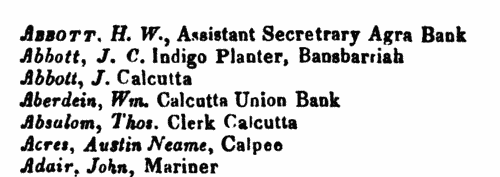
|
Dissolutions of Partnerships
(1838)
Trade partnerships dissolved, or the removal of one partner from a partnership of several traders, in England and Wales
| Sample scan, click to enlarge

|
Dominica Slave Owners (1838)
Slavery was abolished throughout the British Empire by act of Parliament in 1833. This list, published in 1838, gives details of compensation paid to owners who had suffered by the emancipation of their slaves after abolition. The table gives the date of the award, the number of the claim, the full name of the party to whom payment was awarded, the number of slaves, and the sum paid. Few masters had owned more than 100 slaves; most of the claimants had only a few. The cost of the loss of a single slave was generally assessed at about £20. There were 1030 claims from Dominica, including some that were abandoned, disallowed, or still unsettled because of litigation.
| Sample scan, click to enlarge
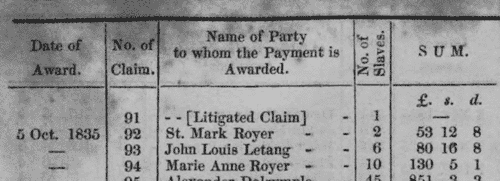
|
Notices to creditors
(1838)
Lists of sums of money due to creditors. | Sample scan, click to enlarge

|
Proprietors of the Bank of England
(1838)
M. A. Marchant of London published this alphabetical list of names and addresses of proprietors of the Bank of England holding £1000 stock and upwards. The number of votes possessed appears against each name; a holder of £4000 had four votes, and no one could have more. | Sample scan, click to enlarge
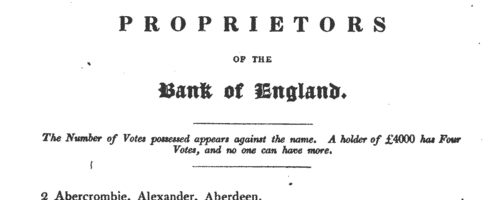
|
Scottish Bankrupts
(1838)
Scotch Sequestrations: bankruptcy often caused people to restart their lives elsewhere, so these are an important source for lost links
| Sample scan, click to enlarge

|
Shareholders of the Liverpool Borough Bank
(1838)
The provincial banks of England and Wales made annual returns to the Stamp Office of their proprietors or shareholders. These returns, registered in March 1838, from the 103 banks then in existence, contain the full names and addresses of nearly 30,000 shareholders. | Sample scan, click to enlarge
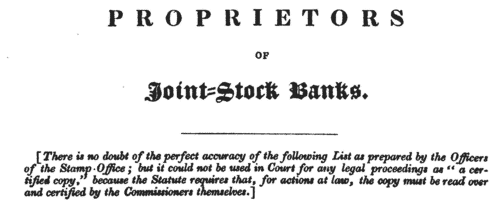
|
Shareholders of the Newcastle-upon-Tyne Joint Stock Banking Company
(1838)
The provincial banks of England and Wales made annual returns to the Stamp Office of their proprietors or shareholders. These returns, registered in March 1838, from the 103 banks then in existence, contain the full names and addresses of nearly 30,000 shareholders. | Sample scan, click to enlarge
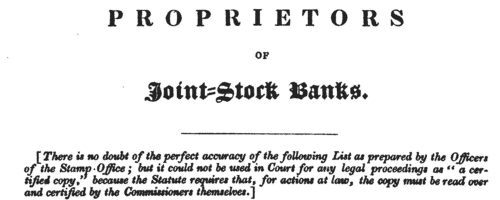
|
Research your ancestry, family history, genealogy and one-name study by direct access to original records and archives indexed by surname.











